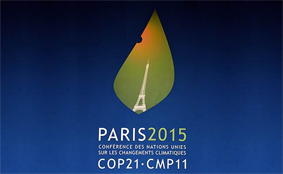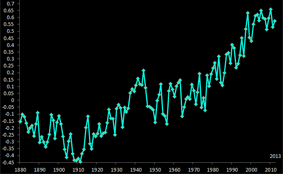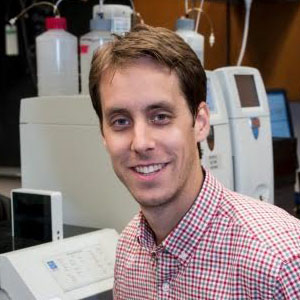The actions we take everyday, whether that is driving to work, eating breakfast, or watching TV, all contributes to our overall personal carbon footprint. Thankfully, we have control over our own impact on climate change and the first step to becoming part of the solution is to understand what aspects of our lifestyle emit greenhouse gas emissions and how much.
This pie chart breaks down an average North American's carbon footprint by category and how much greenhouse gases are emitted from each type of activity. Since this is an average, depending on where you live and your present lifestyle, your piechart will look different. But as you can see, on average, fuel consumption from driving a vehicle (4.6 tons CO2e) and energy used to power a home (Electricity 2.97 tons + Natural Gas 1.08 tons CO2e) represent 45% of a individual's greenhouse gas emissions. Simply by switching to an electric car and ensuring all the energy that is powering your home comes from renewables will have almost halved your carbon footprint!

On average, transportation makes up the largest percentage of a North American's carbon footprint. It is also one of the easiest segments to reduce emissions from. Traveling less, bicycling more, driving an electric car or foregoing car ownership altoghether by participating in car or scooter sharing programs are all things that can help you eliminate the use of fossil fuels in getting around. Flights need to stop, or at the very least, be reserved only for emergency situations.
You can take a positive step right now and Pledge to never buy another gas powered vehicle again and get the "Last Gas Car" bumper sticker. Learn more about the benefits of electric cars and their role in reducing emissions by visiting the 2° Institute's ElectricPledge.org.

The rapidly falling costs and surge in demand of renewable energy like solar is one of the bright spots in our economy that give us hope that we can avoid disastrous climate change. For the average North American, electrical energy consumption at home is the second single biggest source of emissions in their carbon footprint. If you own a home, putting enough solar panels on your roof to power and heat your home and your electric car (if you have one) is the best thing you can do to reduce carbon emissions in this segment.
In some parts of North America were the energy grid is powered primarily by coal, switching to renewable energy before you buy an electric car is recommended. If you live in a condo and putting solar on your roof is not a possibility, purchasing energy from renewable energy companies might be an option in your area.
Replacing all your gas-powered household tools and appliances (eg: gas powered lawnmower, gas stove) with electric or manual powered alternatives is also needed.

Similar to energy to power our products, how we power ourselves has a significant impact on our carbon footprint. The energy from our sun is responsible for powering all life on this planet. Plants obtain energy from the sun, animals obtain energy from plants and animals at the top of the food chain obtain energy from other animals. With each step up in the food chain (trophic level) there is an efficiency loss of roughly 90%. Eating lowest on the food chain (ie: a plant-based diet), that is ideally caloric dense, local & seasonal, is the best way we can lower our carbon footprint in this category.
By eating lower on the food chain, we become more efficient with farmland and require less to feed us. This freed up farmland can be reforested or turned into tree plantations with each tree sequestering CO2 from the atmosphere.

Often when people see the three R's they automatically focus on recycling and not give reduce and reuse much thought. There's a reason why reducing what we consume is the first of the three R's - it is what we should be focusing on first. By getting by with less, we eliminate the emissions that would be generated from the complete life cycle of a new product: obtaining the raw materials, manufacturing, shipping the product, its use and then its disposal at the end of it's life. Even recycling a product produces greenhouse gas emissions so we as individuals need to think about the importance of "Reduce" before deciding to buy something new.
If there is something we need, buying a second hand product, borrowing or participating in a sharing program is what we need to do whenever possible.

The historic Paris Climate Conference of December 2015 resulted in 197 countries resolving to limit the planet's average global temperature to below a 2°C rise from pre-industrial levels to avoid a critical threshold above which the planet could experience irreversible catastrophic impacts.
Climate Scientists have calculated that a safe atmospheric CO2eq limit is 350PPM which translates to approximately a 1°C of warming from pre-industrial levels. Currently, our CO2 levels are much higher than 350PPM so we have our work cut out for us to not only stop emitting greenhouse gases, but to sequester the excess CO2 already in the atmosphere. To achieve this, governments and citizens in these countries will each need to do their part to reduce their own carbon footprint and begin drawing down atmospheric carbon in order to stabilize the climate.

The 2° Institute mission is to develop and support strategies that empower people to make the behavioural and lifestyle changes needed to keep global warming below 2 degrees celsius from pre-industrial levels and restore a stable climate.
Instead of laying blame externally and calling on government and industry to change their ways (which some other NGO's excel at), our focus is to direct people to look inwards at their own contribution to global warming. The average North American's carbon footprint is roughly 4 times the global average so there is a clear opportunity to see drastic reductions on global emissions just by focusing on this continent. The average individual's carbon footprint consists of greenhouse gas emissions from the following categories: Travel, Home Energy, Food, and Goods and Services. Our aim is to offer a clear and achievable roadmap for individuals to drastically reduce their carbon footprint that is commensurate with the scale of the problem.

Headquartered on the west coast of British Columbia, the 2° Institute is a branch of the Clean Air Society of the Sunshine Coast. Since 2003, the organization has worked to educate the public on the science and repercussions of black carbon and other forms of air pollution on human health and the environment.
Climate Data for the Public
The 2° Institute offers interactive real-time climate graphs to aid educators, researchers and the general public in better understanding greenhouse gas levels and the role they play in climate change. These interactive graphs can be freely embedded on any website. Visit ClimateLevels.org, CO2Levels.org or TemperatureRecord.org.

Dr. Pieter Tans
Climate Scientist
NOAA's Earth System Research Laboratory

Dr. Paul Slovic
Behavioural Psychologist
University of Oregon

Dr. Jeremy Shakun
Climate Scientist
Boston College

James Hoggan
Author, Public Relations Expert
DeSmogBlog, Hoggan and Assoc.

Dr. Hendrik Wolff
Environmental Economist
Simon Fraser University

Barry Saxifrage
Climate Research & Reporting
VisualCarbon & National Observer

Dr. Geoff Dutton
Climate Scientist
NOAA's Earth System Research Laboratory

Louis Legal
President,
Sechelt, BC

Dr. John Field
Director
Kleindale BC

Elizabeth Lytviak
Director
Vancouver, BC

Ryan Christopher
Director
Garden Bay, BC

Joe Harrison
Director
Kleindale BC

Valerie Thorsteinson
Director
Sechelt, BC